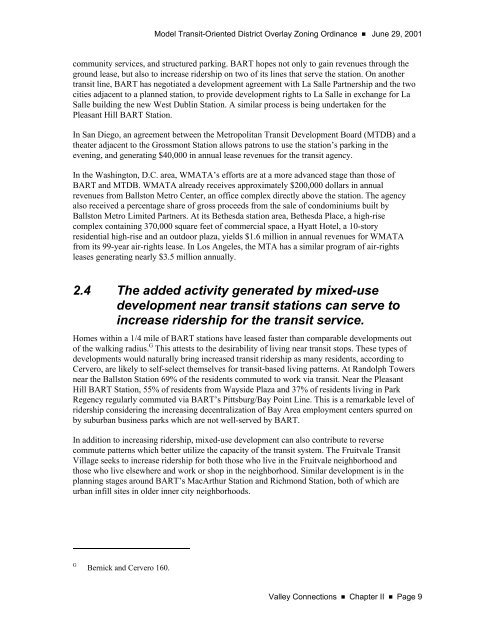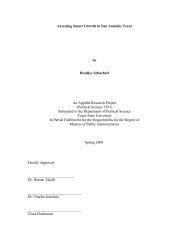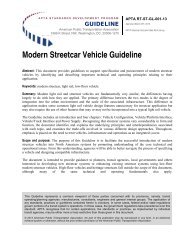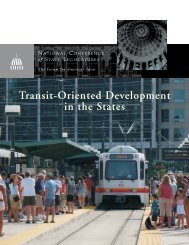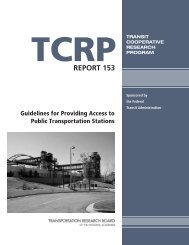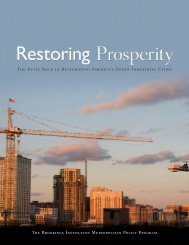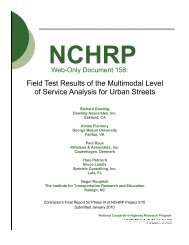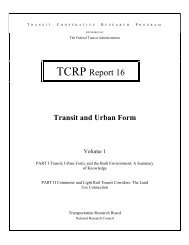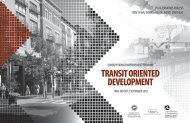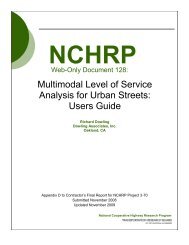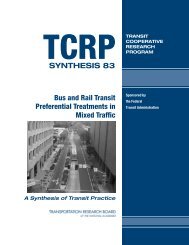Model TOD Zoning Ordinance (PDF, 3.7 MB) - Reconnecting America
Model TOD Zoning Ordinance (PDF, 3.7 MB) - Reconnecting America
Model TOD Zoning Ordinance (PDF, 3.7 MB) - Reconnecting America
You also want an ePaper? Increase the reach of your titles
YUMPU automatically turns print PDFs into web optimized ePapers that Google loves.
<strong>Model</strong> Transit-Oriented District Overlay <strong>Zoning</strong> <strong>Ordinance</strong> ■ June 29, 2001community services, and structured parking. BART hopes not only to gain revenues through theground lease, but also to increase ridership on two of its lines that serve the station. On anothertransit line, BART has negotiated a development agreement with La Salle Partnership and the twocities adjacent to a planned station, to provide development rights to La Salle in exchange for LaSalle building the new West Dublin Station. A similar process is being undertaken for thePleasant Hill BART Station.In San Diego, an agreement between the Metropolitan Transit Development Board (MTDB) and atheater adjacent to the Grossmont Station allows patrons to use the station’s parking in theevening, and generating $40,000 in annual lease revenues for the transit agency.In the Washington, D.C. area, WMATA’s efforts are at a more advanced stage than those ofBART and MTDB. WMATA already receives approximately $200,000 dollars in annualrevenues from Ballston Metro Center, an office complex directly above the station. The agencyalso received a percentage share of gross proceeds from the sale of condominiums built byBallston Metro Limited Partners. At its Bethesda station area, Bethesda Place, a high-risecomplex containing 370,000 square feet of commercial space, a Hyatt Hotel, a 10-storyresidential high-rise and an outdoor plaza, yields $1.6 million in annual revenues for WMATAfrom its 99-year air-rights lease. In Los Angeles, the MTA has a similar program of air-rightsleases generating nearly $3.5 million annually.2.4 The added activity generated by mixed-usedevelopment near transit stations can serve toincrease ridership for the transit service.Homes within a 1/4 mile of BART stations have leased faster than comparable developments outof the walking radius. G This attests to the desirability of living near transit stops. These types ofdevelopments would naturally bring increased transit ridership as many residents, according toCervero, are likely to self-select themselves for transit-based living patterns. At Randolph Towersnear the Ballston Station 69% of the residents commuted to work via transit. Near the PleasantHill BART Station, 55% of residents from Wayside Plaza and 37% of residents living in ParkRegency regularly commuted via BART’s Pittsburg/Bay Point Line. This is a remarkable level ofridership considering the increasing decentralization of Bay Area employment centers spurred onby suburban business parks which are not well-served by BART.In addition to increasing ridership, mixed-use development can also contribute to reversecommute patterns which better utilize the capacity of the transit system. The Fruitvale TransitVillage seeks to increase ridership for both those who live in the Fruitvale neighborhood andthose who live elsewhere and work or shop in the neighborhood. Similar development is in theplanning stages around BART’s MacArthur Station and Richmond Station, both of which areurban infill sites in older inner city neighborhoods.GBernick and Cervero 160.Valley Connections ■ Chapter II ■ Page 9


